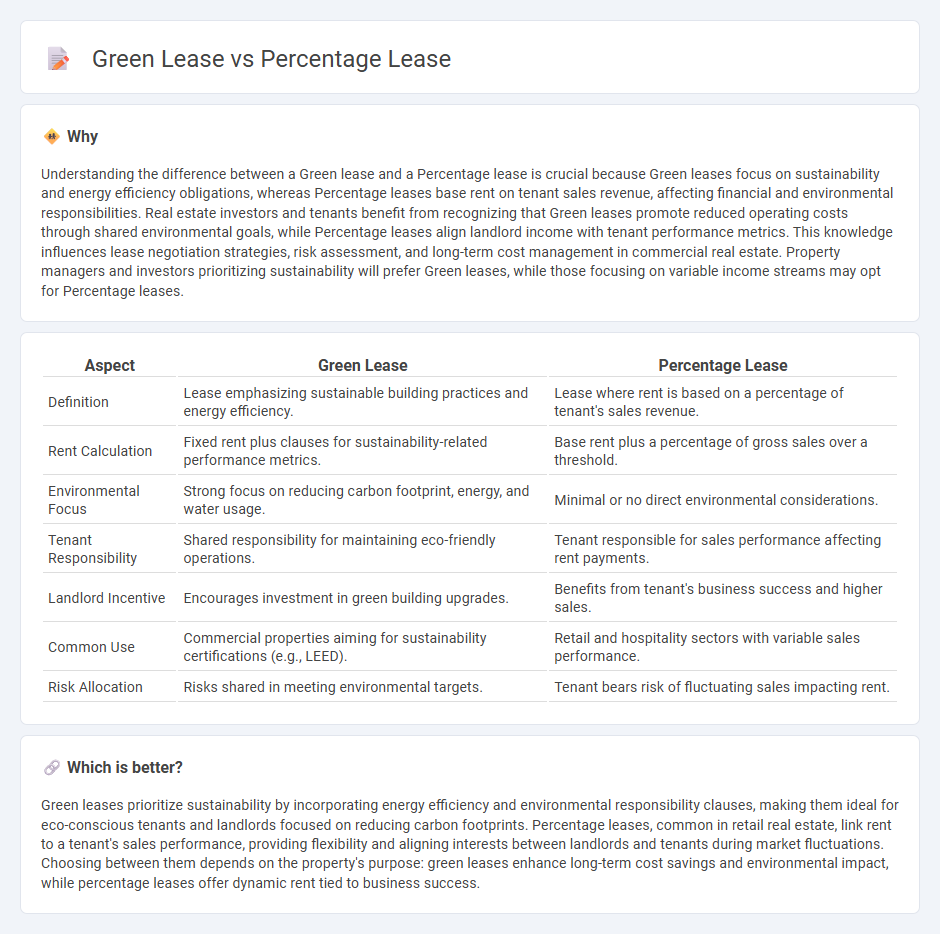
Green leases prioritize sustainability by incorporating environmental performance standards and energy efficiency measures into rental agreements, benefiting both landlords and tenants. Percentage leases base rental payments on a fixed percentage of the tenant's gross sales, commonly used in retail properties to align rent with business success. Discover the key differences and benefits of green and percentage leases to optimize your real estate strategy.
Why it is important
Understanding the difference between a Green lease and a Percentage lease is crucial because Green leases focus on sustainability and energy efficiency obligations, whereas Percentage leases base rent on tenant sales revenue, affecting financial and environmental responsibilities. Real estate investors and tenants benefit from recognizing that Green leases promote reduced operating costs through shared environmental goals, while Percentage leases align landlord income with tenant performance metrics. This knowledge influences lease negotiation strategies, risk assessment, and long-term cost management in commercial real estate. Property managers and investors prioritizing sustainability will prefer Green leases, while those focusing on variable income streams may opt for Percentage leases.
Comparison Table
| Aspect | Green Lease | Percentage Lease |
|---|---|---|
| Definition | Lease emphasizing sustainable building practices and energy efficiency. | Lease where rent is based on a percentage of tenant's sales revenue. |
| Rent Calculation | Fixed rent plus clauses for sustainability-related performance metrics. | Base rent plus a percentage of gross sales over a threshold. |
| Environmental Focus | Strong focus on reducing carbon footprint, energy, and water usage. | Minimal or no direct environmental considerations. |
| Tenant Responsibility | Shared responsibility for maintaining eco-friendly operations. | Tenant responsible for sales performance affecting rent payments. |
| Landlord Incentive | Encourages investment in green building upgrades. | Benefits from tenant's business success and higher sales. |
| Common Use | Commercial properties aiming for sustainability certifications (e.g., LEED). | Retail and hospitality sectors with variable sales performance. |
| Risk Allocation | Risks shared in meeting environmental targets. | Tenant bears risk of fluctuating sales impacting rent. |
Which is better?
Green leases prioritize sustainability by incorporating energy efficiency and environmental responsibility clauses, making them ideal for eco-conscious tenants and landlords focused on reducing carbon footprints. Percentage leases, common in retail real estate, link rent to a tenant's sales performance, providing flexibility and aligning interests between landlords and tenants during market fluctuations. Choosing between them depends on the property's purpose: green leases enhance long-term cost savings and environmental impact, while percentage leases offer dynamic rent tied to business success.
Connection
Green leases and percentage leases intersect in real estate by aligning tenant rent obligations with sustainable building performance and property revenue. Green leases incorporate clauses that promote energy efficiency and environmentally friendly practices, which can influence the variable rent component in percentage leases tied to tenant sales or property income. This connection incentivizes tenants to adopt green practices, potentially reducing operating costs and enhancing overall property value.
Key Terms
Rent Calculation
Percentage leases calculate rent based on a fixed base amount plus a percentage of the tenant's gross sales, aligning landlord income with tenant business performance. Green leases incorporate clauses for sustainability goals, adjusting rent based on energy use, waste reduction, or shared costs from green improvements, promoting environmental responsibility. Explore detailed comparisons to understand which lease type best supports your financial and sustainability objectives.
Operating Expenses
Percentage leases tie tenant rent to a percentage of gross sales, often excluding operating expenses, which the landlord recovers separately through additional rent. Green leases specifically allocate responsibilities for operating expenses related to sustainability measures, encouraging tenants and landlords to share costs and benefits of energy savings and environmental performance. Explore the differences further to optimize lease agreements for cost management and sustainability goals.
Sustainability Clauses
Percentage leases often lack explicit sustainability clauses, tying rent to tenant sales rather than environmental performance, which can limit incentives for energy efficiency improvements. Green leases incorporate specific sustainability requirements, such as energy consumption targets, waste reduction practices, and renewable energy usage, promoting eco-friendly building operations and shared responsibilities between landlords and tenants. Explore more on how these lease structures drive sustainable property management for quantifiable environmental impact.
Source and External Links
Percentage Lease | Formula + Calculator - This webpage provides detailed information on percentage leases, including their structure and calculation methods.
Percentage Lease: How Does It Work in Commercial Real Estate - This article explains how percentage leases work, highlighting their benefits and components in commercial real estate.
Percentage Leases in Commercial Real Estate - This page offers insights into the mechanics of percentage leases, including breakpoints and percentage rates commonly used in commercial real estate.
 dowidth.com
dowidth.com